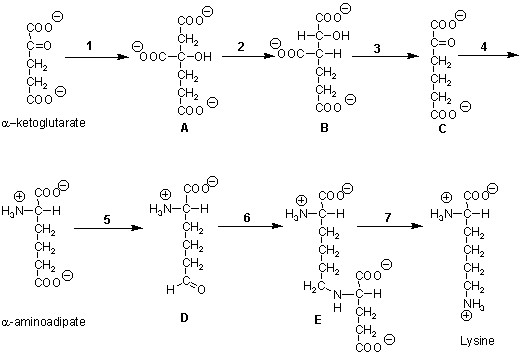
Lysine Biosynthesis in Fungi
Lysine, an essential amino acid for animals, can be synthesized by bacteria, algae, fungi, and higher plants. Two completely different biosynthetic pathways for lysine have evolved; one starting with aspartate and the other with a-ketoglutarate. The intermediates in the latter pathway found in Neurospora crassa (a fungi) are shown below.

1. What would be a likely donor of the two carbon moiety added in Reaction 1?
2. Steps 3, 5, 6, and 7 are oxidation-reduction reactions. What cofactor requirements should each of these these steps have? Explain.
3. Step 5 is analogous in reverse direction to the formation of 3-phospho-glycerate from glyceraldehyde-3-P in glycolysis. What additional cofactor requirement would one expect in Step 5?
4. What cofactor might be expected for Step 4? Look up transamination. (Do not consider reductive amination).
5. One could conceive of a simple reaction converting Compound D to lysine directly. This obviously does not happen given the existence of Compound E What compound is added in Step 6? What compound is lost in Step 7?
6. Steps 1 through 3 in sequence are analogous to what other more familiar sequence of reactions? In what way do the two sets of reactions differ? (Hint: Compare the shift of the hydroxyl in both cases and its implications.
7. Ornithine is an amino acid with one less methylene group than lysine. It is an important intermediate in arginine biosynthesis and in the urea cycle. What TCA cycle intermediate should be a direct precursor of ornithine?
8. Assuming the a-amino adipate pathway is unbranched, what step would be likely to regulate the flow of intermediates in the pathway? What mode of regulation would be expected?
9. Neurospora crassa was grown in the presence of 1-14C-a ketoglutarate and 2-14C-a -ketoglutarate in successive experiments. Indicate which carbons, if any, would be labeled in lysine and saccharopine (Compound E) for each experiment .
10. A mutant lacking Step 4 activity might be expected
to accumulate Compound C. This mutant will grow in the presence of a-amino
adipate but no longer accumulates C. What might be a reasonable explanation
for this phenomenon?